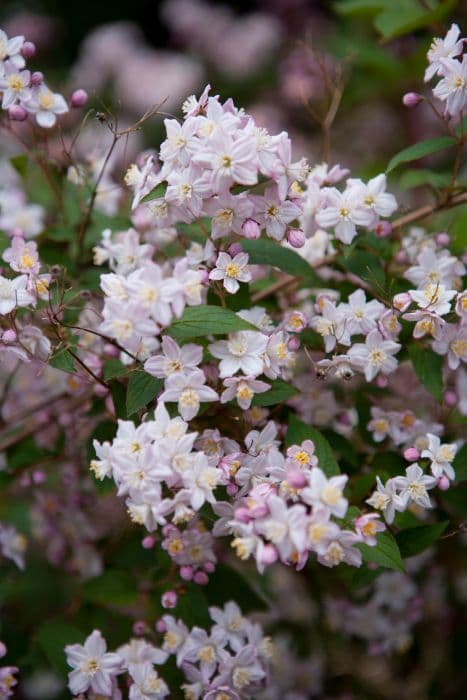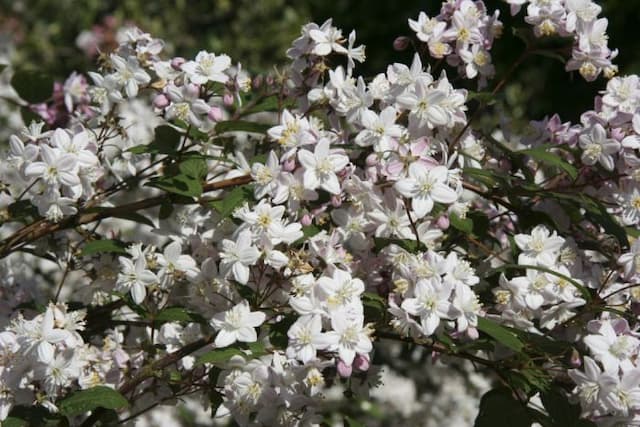Bigleaf Hydrangea Hydrangea macrophylla 'Love You Kiss' (PBR) (Hovaria Series) (L)

ABOUT
The plant Hydrangea 'Love You Kiss', a member of the Hovaria Series, boasts an enchanting display of flowers. These blooms are distinguished by their two-toned color scheme, featuring rosy-pink edges that gracefully fade into a white center, creating a romantic and delicate appearance. This captivating color transformation occurs on each individual flower, lending it an exquisitely unique character. As the seasons change, the blossoms can exhibit a shift in their hue, taking on deeper or lighter shades depending on the climate and soil conditions. The large flower heads are made up of numerous smaller flowers, presenting a lush, full look that adds to the overall charm of the shrub. The leaves of the Hydrangea 'Love You Kiss' provide a beautiful backdrop for the flowers, with a deep green color and a glossy texture that reflects the sunlight, enhancing the vibrancy of the plant. The foliage is dense and provides a continuous canvas of green even when the plant is not in bloom. The overall shape of the hydrangea is rounded, with sturdy stems that support the weight of the flowers, ensuring they are displayed prominently. The plant's visual appeal makes it a favored choice for gardeners looking to add a touch of elegance and a splash of color to their landscapes.
About this plant
 Names
NamesFamily
Hydrangeaceae
Synonyms
Love You Kiss Hydrangea, Hovaria Hydrangea
Common names
Hydrangea macrophylla 'Love You Kiss'.
 Toxicity
ToxicityTo humans
The common name for Hydrangea macrophylla 'Love You Kiss' (PBR) (Hovaria Series) (L) is Hydrangea. Hydrangeas are considered to have a low level of toxicity to humans. However, if ingested, parts of the plant can cause gastrointestinal upset, such as vomiting and diarrhea. The plant contains compounds like hydrangin, a cyanogenic glycoside, which can release cyanide when metabolized. Large quantities would need to be consumed to cause serious poisoning. The most common consequences of ingesting parts of the hydrangea are typically mild and may include stomach pain and nausea.
To pets
The common name for Hydrangea macrophylla 'Love You Kiss' (PBR) (Hovaria Series) (L) is Hydrangea. Hydrangeas are known to be toxic to pets, including cats and dogs. If ingested, the plant can cause gastrointestinal upset in pets, which may present as vomiting, diarrhea, and lethargy. The toxic principle is hydrangin, which is a type of cyanogenic glycoside. It has the potential to release cyanide into the animal's system when digested. While typically, pets would need to ingest a significant quantity of the plant to cause severe poisoning, even smaller amounts can result in discomfort and signs of illness. It is advised to keep pets away from hydrangeas and to contact a veterinarian if you suspect your pet has ingested hydrangea plant material.
 Characteristics
CharacteristicsLife cycle
Perennials
Foliage type
Deciduous
Color of leaves
Green
Flower color
Pink
Height
4 feet [1.2 meters]
Spread
4 feet [1.2 meters]
Plant type
Shrub
Hardiness zones
5
Native area
Japan
Benefits
 General Benefits
General Benefits- Ornamental Appeal: Hydrangea macrophylla 'Love You Kiss' features large, colorful blooms that add visual interest to gardens and landscapes.
- Long Blooming: This variety typically has a long blooming season, providing extended periods of color throughout spring and summer.
- Versatile Landscaping: Ideal for borders, hedges, or as a focal point in garden beds, the plant's size and shape offer multiple landscaping options.
- Attracts Pollinators: The flowers attract butterflies and other pollinators, which is beneficial for the health of gardens and the environment.
- Adapts to Soil pH: The flower color can change based on the soil pH, offering variety and uniqueness in the garden.
- Easy to Propagate: It can be easily propagated from cuttings, which means gardeners can create more plants for other areas or to share.
- Shade Tolerance: Hydrangeas can tolerate partial shade, which makes them suitable for different garden aspects.
- Seasonal Interest: In addition to flowers, some hydrangeas have attractive autumn foliage or peeling bark, offering seasonal interest beyond the blooming period.
 Medical Properties
Medical PropertiesThis plant is not used for medical purposes.
 Air-purifying Qualities
Air-purifying QualitiesThis plant is not specifically known for air purifying qualities.
 Other Uses
Other Uses- Crafting Dried Flower Arrangements: The blooms of the Hydrangea can be dried and used in crafting intricate dried floral arrangements for home decor or special occasions.
- Natural Fabric Dyes: The vibrant petals of the Hydrangea can be boiled to extract color and used as a natural fabric dye for textiles, yielding beautiful shades of blue, purple, or pink, depending on the pH of the soil they were grown in.
- Garden Weddings: Hydrangea flowers are often utilized in garden weddings for their lush, full-headed appearance, either as part of the bridal bouquets, table centerpieces, or aisle decorations.
- Photography: The striking colors and full blooms make Hydrangeas an excellent subject or backdrop for outdoor portrait photography.
- Pressed Flower Art: Individual petals or entire Hydrangea flowers can be pressed and used to create unique, artistic designs on greeting cards or bookmarks.
- Feng Shui: In certain cultural practices, Hydrangeas are used in Feng Shui to attract love and prosperity when placed in the right area of a home or garden.
- Culinary Garnish: Although not commonly eaten, certain parts of the Hydrangea are safe to eat and can be used as an ornate, albeit unusual, garnish for high-end culinary presentations.
- Botanical Illustration and Education: Artists and educators may use Hydrangeas as subjects for botanical illustrations or as part of educational materials due to their distinctive morphology.
- Cosmetics and Perfumery: While avoiding direct usage due to potential toxicity, the essence of Hydrangea's fragrance might inspire scents for cosmetics and perfumes.
- Hydrangea Festivals: The bloom of Hydrangeas can be the central theme for community festivals, which celebrate the flower through local art, crafts, and cultural performances.
Interesting Facts
 Feng Shui
Feng ShuiThe Hydrangea is not used in Feng Shui practice.
 Zodiac Sign Compitability
Zodiac Sign CompitabilityThe Hydrangea is not used in astrology practice.
 Plant Symbolism
Plant Symbolism- Heartfelt Emotions: The Hydrangea commonly symbolizes heartfelt and genuine emotions. The variety 'Love You Kiss' with its lush flower heads may be specifically suggestive of abundant feelings or the overflowing nature of love.
- Gratitude: Hydrangeas can express gratitude, making them suitable for thank you gifts or gestures of appreciation.
- Understanding: They are often associated with the idea of understanding. This could stem from their full, rounded blooms that encompass a wide range of individual flowers, each representing unique thoughts.
- Apologetic Gestures: In some contexts, hydrangeas may signify apology or remorse, used for seeking forgiveness.
- Vanity or Frivolity: Historically, hydrangeas have had negative connotations such as vanity or egotism, likely due to their showy and sometimes changeable colors.
- Fourth Wedding Anniversary: They are linked with the fourth wedding anniversary, representing appreciation and enduring love.
 Water
WaterBigleaf hydrangeas, like the 'Love You Kiss,' require consistent moisture and should be watered deeply once a week, with about 1 gallon of water per plant during the growing season. In hot or windy weather, they may need additional water to prevent wilting. Always water at the base of the plant to keep moisture off the leaves and flowers, reducing the risk of leaf spot and other fungal diseases. During the winter months, reduce watering but don't allow the soil to completely dry out.
 Light
LightBigleaf hydrangeas thrive in partial shade with some morning sun and afternoon shade to protect their blooms from intense heat. A spot that receives dappled sunlight throughout the day is ideal. Avoiding exposure to full afternoon sun will help prevent scorching of the leaves and flowers.
 Temperature
TemperatureBigleaf hydrangeas perform best in an environment with temperatures ranging from 50°F to 85°F. While they can tolerate a freeze, temperatures below 25°F may damage the plant. Ideal growth occurs when daytime temperatures are around 70°F. Ensuring protection from extreme heat or frost can help maintain plant health.
 Pruning
PruningPrune bigleaf hydrangeas only immediately after flowering to shape the plant or remove dead wood, as they bloom on old wood. Avoid heavy pruning or cutting back in the late fall or winter, as this can remove next year's flower buds. Annually remove only the oldest stems to encourage vigorous, healthy growth.
 Cleaning
CleaningAs needed
 Soil
SoilBigleaf hydrangeas require well-draining, rich, loamy soil with a pH of about 5.5 for pink blooms. An ideal mix might be garden soil, compost, and peat moss in equal parts to enhance nutrition and drainage.
 Repotting
RepottingBigleaf hydrangeas should be repotted every 2-3 years to prevent root-bound conditions and replenish the soil nutrients.
 Humidity & Misting
Humidity & MistingBigleaf hydrangeas thrive best at humidity levels of 60-70%, especially during their active growing season.
 Suitable locations
Suitable locationsIndoor
Choose bright, indirect light, and keep the soil moist for indoor hydrangeas.
Outdoor
Plant in part shade, mulch well, and water regularly for outdoor settings.
Hardiness zone
5-9 USDA.
 Life cycle
Life cycleThe life cycle of Hydrangea macrophylla 'Love You Kiss' begins with seed germination, typically in early spring, under warm and moist conditions that facilitate root and shoot development. The seedling grows into a juvenile plant, gradually developing a robust root system and foliage. As the plant matures, it enters the vegetative stage, producing large, lush leaves and strong stems in preparation for blooming. Once the hydrangea reaches maturity, it enters the flowering stage, typically in early summer, displaying its characteristic large flowers that can be pink, blue, or purple, depending on soil pH. After the blooming period, the flowers may fade and seeds develop, which can be dispersed for reproduction, or the plant can be propagated asexually through cuttings. In autumn, the hydrangea enters a dormant phase, losing leaves in response to cooler temperatures and shorter days, but the root system remains alive, allowing the plant to regrow and repeat the cycle the following spring.
 Propogation
PropogationPropogation time
Spring-Early Summer
The Hydrangea, particularly the Hydrangea macrophylla 'Love You Kiss', is best propagated from semi-hardwood cuttings taken in late summer as the plant begins to go dormant. To propagate, select a healthy stem with several leaves and cut a section 4 to 6 inches long just below a leaf node using sharp, sterilized pruning shears. Remove the lower leaves, leaving two or three near the top, and dip the cut end into rooting hormone powder. Plant the cutting into a pot filled with moistened potting mix or a mix of perlite and peat, ensuring at least one leaf node is beneath the surface. Cover the cutting with a plastic bag to maintain humidity and place in indirect light. Roots typically develop within 4 to 8 weeks, after which the new Hydrangea can be transplanted to a larger pot or outdoors.






![Hydrangea [Early Sensation]](/_next/image?url=https%3A%2F%2Fplants-admin.emdemapps.com%2Fimages%2Fplants%2F%2Fimages%2F604b6150338db.png&w=640&q=75)


